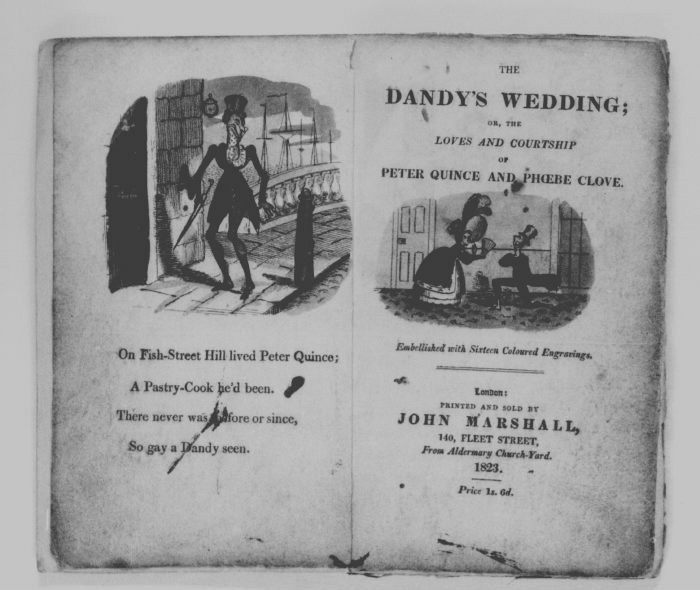Poetry, Verse and Rhymes; Games. 0761: Anon., The Dandy's Wedding
| Author: |
Anon. |
| Title: |
The dandy's wedding; or, the loves and courtship of Peter Quince and Phoebe Clove. Embellished with sixteen coloured engravings |
| Cat. Number: |
0761 |
| Date: |
1823 |
| 1st Edition: |
|
| Pub. Place: |
London |
| Publisher: |
John Marshall, 140, Fleet Street |
| Price: |
1s 6d |
| Pages: |
1 vol., pp32 |
| Size: |
18 x 10 cm |
| Illustrations: |
16 engravings, some coloured in pastels |
| Note: |
Inscription: 'Nancy Davis' |
Images of all pages of this book

Introductory essay
This curious verse history of the courtship of Peter Quince and Phoebe Clove might almost be regarded as an early example of nonsense verse. The narrative, such as it is, is disjointed and confusing, and serves only to string together several isolated comic episodes, each illustrated by a humorous engraving. Much of the humour is derived from the gentle mockery, carried by both the text and images, or the pretensions to fashion of Peter and Phoebe. They are represented as recently-rich parvenus, who affect the manners of their social superiors. Peter had been a pastry-cook, the very first page informs the reader, and there are constant reminders of his humble background - such as the glimpse of St. Paul's Cathedral though his window on p.8, which locates his home within the City of London rather than in the more fashionable Westminster. In fact, it is fashion itself that bears the brunt of the book's satirical sallies. Both Peter and Phoebe are depicted wearing outlandish clothes, and the unnaturalness of their toilette and their corsetry is alluded to. Peter's propensity to fall ill when he thinks he has a rival in love is presented as risible (as is the doctor who attends him: p.6), and the lovers' trip to the theatre, as a prelude to their wedding, suggests that their courtship is just as artificial as the sort of high-blown drama to be seen on the stage behind them (p.14).



